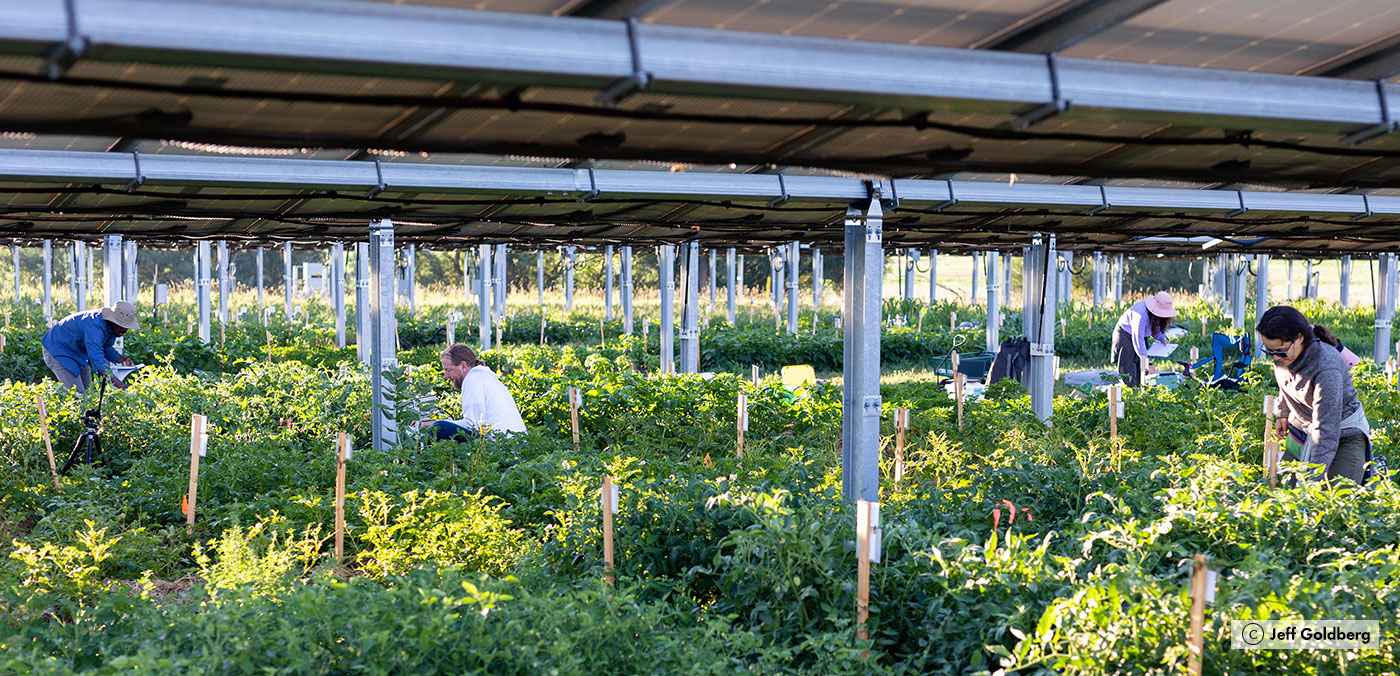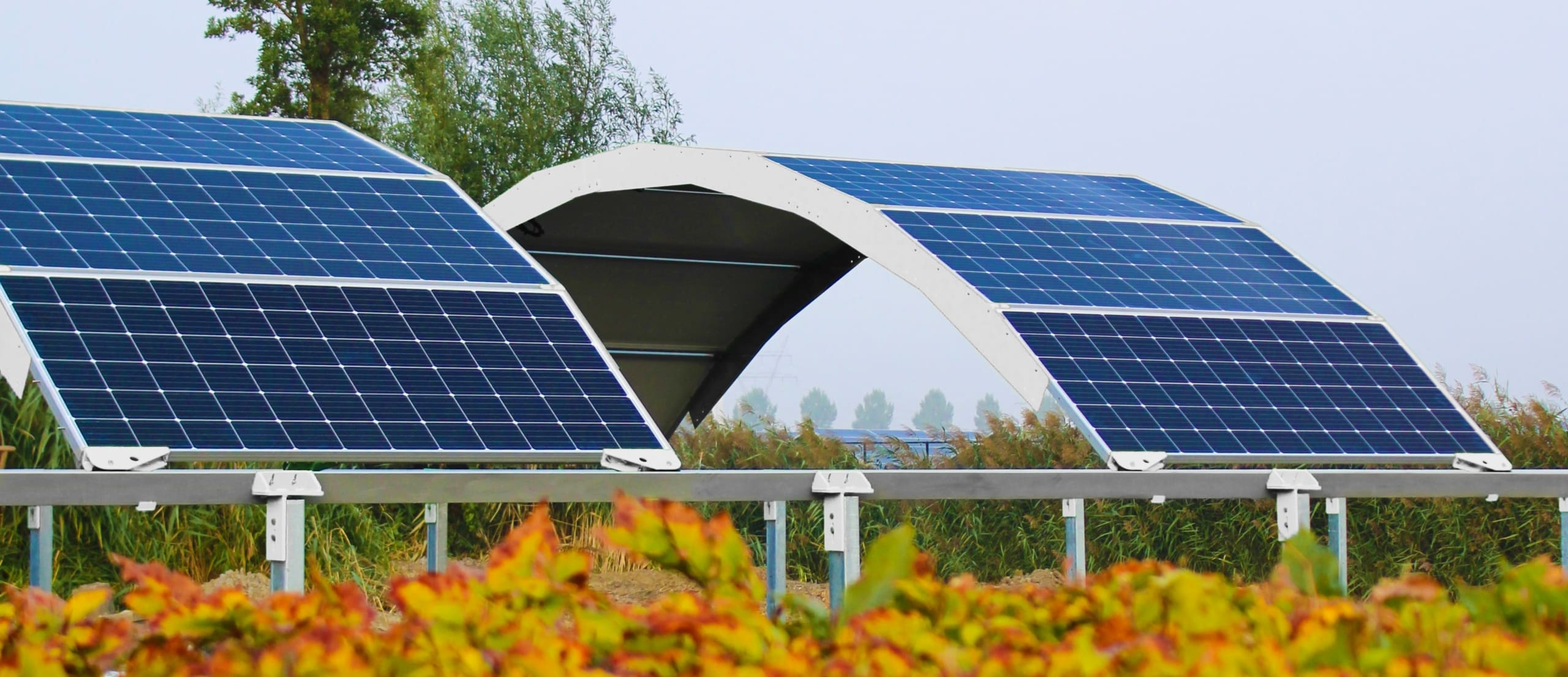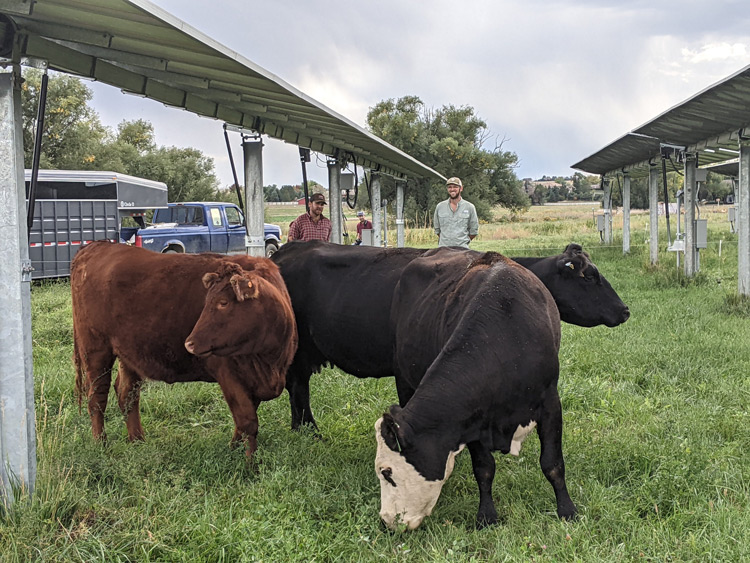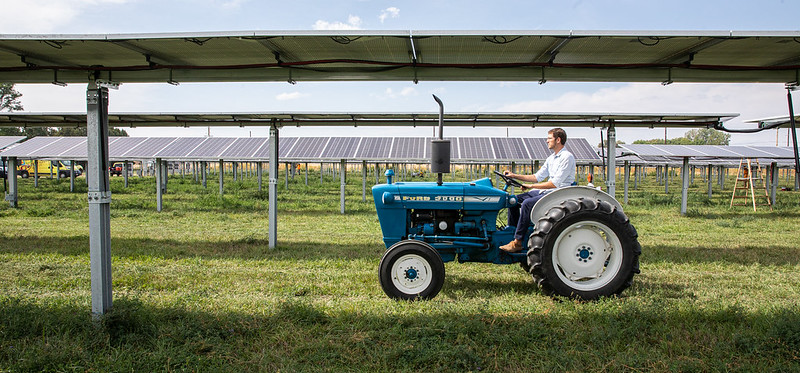Agrivoltaics: Blue-green model for the future

Agrivoltaics is a blue-green glimmer of hope in an era of climate change. It refers to the simultaneous use of an area for agricultural production and the generation of electricity from photovoltaics. Until now, agricultural land and ground-based PV systems have mostly existed separately. Anyone who purposefully combines the two forms of land use can benefit from positive effects.
The math adds up: agrivoltaics makes for extremely efficient land use

Prof. Dr. Kerstin Wydra from the Erfurt University of Applied Sciences is researching the topic of Agri-PV: The dual use of arable land for food and solar power makes a significant contribution against global warming and to securing the food supply.
Photo: Thüringer Erneuerbare Energien Netzwerk (ThEEN) e.V.
First, let’s assume that mounting the PV panels takes up a maximum of 15% of an agrivoltaics area, or that it is too shady there for crops. Second, that the electricity yield will be about 20% lower due to the greater row spacing compared with a ground-based PV system. This adds up to 85% plus 80%, or 165% productivity overall. The extremely efficient use of land is the main argument in favor of agrivoltaics.
Around the world, agriculture is struggling with extreme weather events such as heavy rain, increasing heat and hail. “In these cases, we can even use a PV system to protect the crops,” explained Dr. Kerstin Wydra, professor of Plant Production and Climate Change at Erfurt University of Applied Sciences. “Agrivoltaics thus offers a huge opportunity as a strategy for adapting agriculture to the extremes of weather that are already occurring and those that are likely to occur in the future. Ultimately, the whole thing has an effect on the soil and biodiversity.”
In a study, she and colleagues investigated the potential of agrivoltaics for the German state of Thuringia. The result was that “the dual use of arable land for food and solar power can make a significant contribution toward halting the warming of our planet and securing the food supply.”
Solar biodiversity

Research projects such as the modular arc system show that agrivoltaics is now also being taken seriously as a prospect for the future in industry.
Source: GOLDBECK SOLAR GmbH
Conventional ground-based PV systems are best located on low-quality soils, paved surfaces or surfaces that are difficult to access. The most important thing to bear in mind when setting up the modules is optimizing orientation to the sun. With agrivoltaics, the PV system can be based on the crop and can look very different, explained Dr. Kerstin Wydra.
The possible applications are as wide-ranging as the technology. Photovoltaic systems are available as rigid structures that are angled toward the sun or are vertical (as with solar façades), in the form of flexible thin-film PV modules or organic PV cells, in more or less transparent designs, and as tracking systems that automatically follow the position of the sun.
For example, for an apple orchard where there have been trees for many years, a fixed canopy at a height of three meters is a good solution. On a poultry farm, where PV modules are intended to provide protection for the animals from the sun and birds of prey, they may be mounted only at waist height.
For greenhouse crops, the conventional glass structure can be replaced in whole or in part by photovoltaic elements. The same applies to anti-hail nets and sheets for fruit and vegetable cultivation.
Vertical PV elements between rows or as crop or pasture boundaries are typically bifacial, meaning that they absorb sunlight from both sides, thereby providing solar power at different times of the day.
Controllable panels are ideal for optimizing power and crop yield. If the apples need a few days of sun to redden, the canopies can be folded out of the way. And it’s not too great a leap to smart solar farming, where the photovoltaics adjust to approaching hailstorms with the help of meteorological data from the Internet.
Potatoes under the collector

If grazing animals graze under the modules, it could make sense to stake out smaller rotation pastures within the PV field.
Photo: Colorado Agrivoltaic Learning Center
As early as 1981, trade journal Sonnenstrom featured an article on “Potatoes Under the Collector.” The article was written by the founder of the Fraunhofer Institute for Solar Energy Systems (ISE), which has been researching the feasibility of agrivoltaics since 2014 in various studies and pilot projects in the Rhineland, but also in Algeria, Chile and Mali.
When the cost of PV modules began to fall a few years ago, there was newfound scope for trying out “crazy” ideas, explained Sophia Judith Bächle from Fraunhofer ISE. And of course, the political will to promote such projects has also contributed to the agrivoltaics scenario finally becoming reality.
Daniel Rosende Völker, Managing Director of Latin America for SMA AG, sees a growing trend. “Our customers are increasingly interested in multi-use land. This is an important approach. After all, we need large areas for the production of renewable energy if the energy transition is to succeed. And if we use these areas in a variety of ways, then we are on the right track.”
On the rise worldwide
It will probably be some time before nurseries, vineyards and potato fields are covered with sufficient PV panels. Countries in which the consequences of climate change are already being clearly felt and where politicians are setting other priorities are further ahead. “China has the largest plant capacity, with 12 gigawatts of nominal power. Worldwide, it’s 14 gigawatts,” said Dr. Kerstin Wydra. In Japan, with its scarce arable land, government support measures have been in place since 2013 and there are now around 2,000 agrivoltaic systems, alongside which 120 different crops, such as berries, grains, mushrooms, tea, coffee, vegetables and herbs, are thriving.
Daniel Rosende Völker is impressed. “In principle, the potential for agrivoltaics in Latin America and in any other region with a relevant agricultural industry is enormous. There are clear technical solutions to the industry’s challenges that are now also commercially attractive.”
Research and pilot plants currently predominate in Central Europe, but commercial operation is becoming increasingly realistic. And the droughts that wreaked havoc in the summer of 2022 make agrivoltaics an attractive option for farms looking to counter the effects of climate change.
Do you want to plan a PV system on agricultural land? With our Sunny Design planning tool, you can see an overview of your options free of charge.


Dear SMA solar manufacturing I want to agriculture training from India if you give me training by your company I will come in your company.
Hello Mratunjay,
Thanks for your kind feedback and your interest in our SMA Solar Academy.
Here you will find more information on our online trainings.
Sunny regards
Christiane